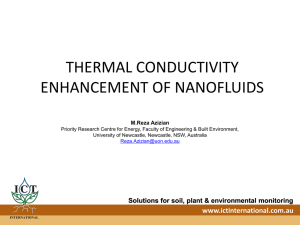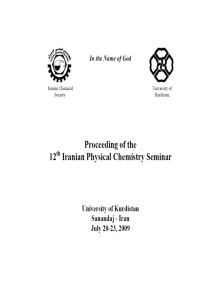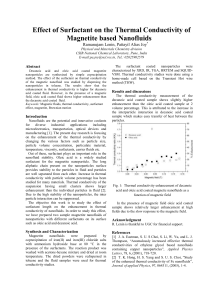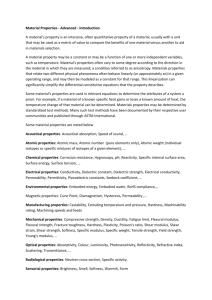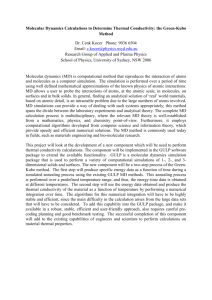Article Template
advertisement
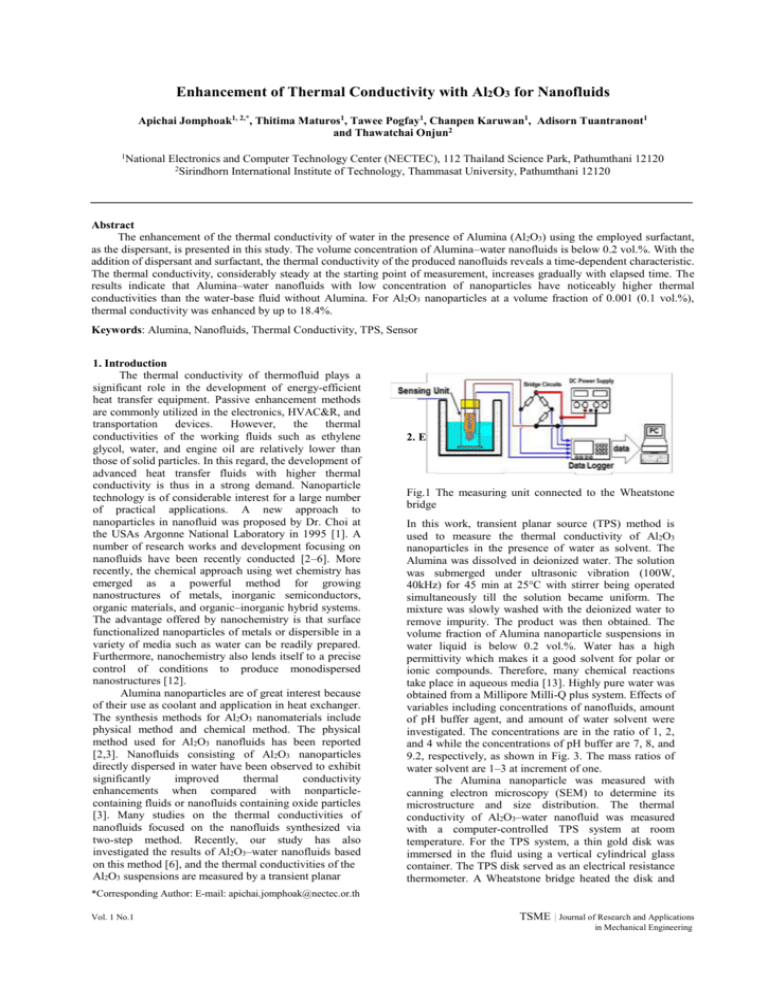
Enhancement of Thermal Conductivity with Al2O3 for Nanofluids Apichai Jomphoak1, 2,*, Thitima Maturos1, Tawee Pogfay1, Chanpen Karuwan1, Adisorn Tuantranont1 and Thawatchai Onjun2 1National Electronics and Computer Technology Center (NECTEC), 112 Thailand Science Park, Pathumthani 12120 2Sirindhorn International Institute of Technology, Thammasat University, Pathumthani 12120 Abstract The enhancement of the thermal conductivity of water in the presence of Alumina (Al 2O3) using the employed surfactant, as the dispersant, is presented in this study. The volume concentration of Alumina–water nanofluids is below 0.2 vol.%. With the addition of dispersant and surfactant, the thermal conductivity of the produced nanofluids reveals a time-dependent characteristic. The thermal conductivity, considerably steady at the starting point of measurement, increases gradually with elapsed time. The results indicate that Alumina–water nanofluids with low concentration of nanoparticles have noticeably higher thermal conductivities than the water-base fluid without Alumina. For Al2O3 nanoparticles at a volume fraction of 0.001 (0.1 vol.%), thermal conductivity was enhanced by up to 18.4%. Keywords: Alumina, Nanofluids, Thermal Conductivity, TPS, Sensor 1. Introduction The thermal conductivity of thermofluid plays a significant role in the development of energy-efficient heat transfer equipment. Passive enhancement methods are commonly utilized in the electronics, HVAC&R, and transportation devices. However, the thermal conductivities of the working fluids such as ethylene glycol, water, and engine oil are relatively lower than those of solid particles. In this regard, the development of advanced heat transfer fluids with higher thermal conductivity is thus in a strong demand. Nanoparticle technology is of considerable interest for a large number of practical applications. A new approach to nanoparticles in nanofluid was proposed by Dr. Choi at the USAs Argonne National Laboratory in 1995 [1]. A number of research works and development focusing on nanofluids have been recently conducted [2–6]. More recently, the chemical approach using wet chemistry has emerged as a powerful method for growing nanostructures of metals, inorganic semiconductors, organic materials, and organic–inorganic hybrid systems. The advantage offered by nanochemistry is that surface functionalized nanoparticles of metals or dispersible in a variety of media such as water can be readily prepared. Furthermore, nanochemistry also lends itself to a precise control of conditions to produce monodispersed nanostructures [12]. Alumina nanoparticles are of great interest because of their use as coolant and application in heat exchanger. The synthesis methods for Al2O3 nanomaterials include physical method and chemical method. The physical method used for Al2O3 nanofluids has been reported [2,3]. Nanofluids consisting of Al2O3 nanoparticles directly dispersed in water have been observed to exhibit significantly improved thermal conductivity enhancements when compared with nonparticlecontaining fluids or nanofluids containing oxide particles [3]. Many studies on the thermal conductivities of nanofluids focused on the nanofluids synthesized via two-step method. Recently, our study has also investigated the results of Al2O3–water nanofluids based on this method [6], and the thermal conductivities of the Al2O3 suspensions are measured by a transient planar 2. Experiments Fig.1 The measuring unit connected to the Wheatstone bridge In this work, transient planar source (TPS) method is used to measure the thermal conductivity of Al2O3 nanoparticles in the presence of water as solvent. The Alumina was dissolved in deionized water. The solution was submerged under ultrasonic vibration (100W, 40kHz) for 45 min at 25°C with stirrer being operated simultaneously till the solution became uniform. The mixture was slowly washed with the deionized water to remove impurity. The product was then obtained. The volume fraction of Alumina nanoparticle suspensions in water liquid is below 0.2 vol.%. Water has a high permittivity which makes it a good solvent for polar or ionic compounds. Therefore, many chemical reactions take place in aqueous media [13]. Highly pure water was obtained from a Millipore Milli-Q plus system. Effects of variables including concentrations of nanofluids, amount of pH buffer agent, and amount of water solvent were investigated. The concentrations are in the ratio of 1, 2, and 4 while the concentrations of pH buffer are 7, 8, and 9.2, respectively, as shown in Fig. 3. The mass ratios of water solvent are 1–3 at increment of one. The Alumina nanoparticle was measured with canning electron microscopy (SEM) to determine its microstructure and size distribution. The thermal conductivity of Al2O3–water nanofluid was measured with a computer-controlled TPS system at room temperature. For the TPS system, a thin gold disk was immersed in the fluid using a vertical cylindrical glass container. The TPS disk served as an electrical resistance thermometer. A Wheatstone bridge heated the disk and *Corresponding Author: E-mail: apichai.jomphoak@nectec.or.th Vol. 1 No.1 TSME | Journal of Research and Applications in Mechanical Engineering JRAME Enhancement of Thermal Conductivity with Al2O3 for Nanofluids simultaneously measured its resistance. The electrical resistance of the gold disk varies in proportion to changes in temperature as shown in Fig. 1. The thermal conductivity was then estimated from Fourier’s law. The transient TPS system was calibrated with the deionized water at room temperature. The Al2O3–water nanofluids were filled into the glass container to measure the thermal conductivity. The inner diameter and length of long glass container are 19 mm and 240 mm, respectively. A time sequence of thermal conductivity measurement of the Alumina nanofluids was conducted at intervals of 1–5 min. The measurement ended up at 30 min when there was no apparent change in the thermal conductivity. The time profile of the thermal conductivity distribution of the Alumina nanofluids then can be examined. Fig. 2 Al size distribution Fig. 3 Effect of pH on thermal conductivity of Al2O3H2O suspensions 3. Results and discussion Alumina nanoparticles are produced in water, and then the Al3+ ions are converted into aluminum atoms. The Al atoms then precipitate to form Alumina nanofluid. The color of the solution will gradually change from transparent to white and even to dark white. The volume fractions of Al nanoparticle suspensions in water liquid are from 0.05% to 0.2 vol.% with an interval of 0.05%. The Al nanoparticles shows the monodispersed distribution of particle sizes, the grain size and shape of Cu–water nanofluids as a function of nanoparticle volume. The agglomerated particle sizes of the Al nanoparticles range from 100–300 nm with spherical shapes. On the other hand, Fig. 3 illustrates a graph of a Al–water nanofluid at 0.2 vol.% (specimen No. 9). The typical particle sizes of the Al nanoparticles are >250 nm with spherical assorted shapes. In tandem with the scanning electron microscope, it is used to determine the chemical composition of a microscopic area of a solid sample. The thermal conductivity increased ratio of Al– water nanofluids as a function of nanoparticle volume 4 fraction. The thermal conductivity ratio of Al–water nanofluids increases with the increase of volume fraction of Al until it reaches the maximum value at 0.1 vol.%. It is interesting to note that above this volume fraction thermal conductivity ratio decreases. This behavior indicates the interesting aspect of Al–water nanofluids, and it is likely that the decrease of thermal conductivity ratio above this threshold fraction is caused by the larger size of Al nanoparticles (>100 nm). The normalized thermal conductivity data for the Al–water nanofluids as a function of the measured time is shown in Fig. 3. The k denotes the thermal conductivity of Al–water suspensions and the kbase is the thermal conductivity of the water base fluid. The Al nanofluid is added into the vertical cylindrical glass container of the transient planar source (TPS) system after cooling down. By prescribing the input temperature to the Al nanofluid, the associated thermal conductivity was measured directly by the TPS system and adjusting the variable resistor of the Wheatstone bridge circuit accordingly. The measurement of thermal conductivity could begin without further agitating in the glass container. Therefore, it takes about 1 min to get the first point of thermal conductivity after the Al nanofluid is added. This point is regarded as the first measured point at 1 min. During the thermal conductivity measurement, the Al nanofluid is kept as it is with no further action. On the other hand, it is also possible that the Al nanoparticles with addition of dispersant and surfactant could be agglomerated to some extent, not separated individually. Therefore, the thermal conductivity of the Al nanofluid shows the timedependent behavior. However, the addition of dispersant and surfactant would make the Al surface coated, thereby resulting in the screening effect on the heat transfer performance of Al nanoparticle. From this figure, one can see that Al–water nanofluids with a low concentration of nanoparticles have considerably higher thermal conductivities than the identical water base liquids without solid nanoparticles. A strong dependence of thermal conductivity on the measured time is observed. In addition, one can also see that at a constant volume fraction, k/kbase is the largest at the starting point of measurement and drops considerably with elapsed time. For Al nanoparticles at a volume fraction of 0.001 (0.1 vol.%), thermal conductivity is enhanced by 18.4%. The ratio of k/kbase is almost unchanged when the elapsed time is above 10 min. The value of k/kbase is slightly above unity, indicating no appreciable enhancements due to the particles agglomeration. The fluids with solid particles on a nanoscale show better thermal conductivities than those with none. This is due to the larger total surface areas of nanoparticles. Some possible explanations of the enhancement of nanoscale particles can be found from Lee et al. [14]. It can therefore be expected that their respective nanofluids’ thermal conductivity behave differently. The corresponding Al nanoparticles were about 100 nm diameter and were directly mixed with deionized water at several weight percents which was used to enhance stability of the suspension. In this study, with the addition of surfactant, the surface of Al nanoparticle contacts the water solvent directly to enhance the thermal conductivity effectively. The heat transfer at the free surface of the nanoparticles is more active than the coated surface with stabilizing agents. The Brownian motion on the nanoparticles at the molecular and nanoscale level is a major mechanism Journal of Research and Applications in Mechanical Engineering (JRAME) controlling the thermal conductivity of nanofluid. The fundamental difference between solid/solid composites and solid/liquid suspensions is identified. Thus the solid/liquid interface characteristics need to be exploited. A significant increase in thermal conductivity up to 18.4% is observed at a single measurement point. The thermal conductivity decreases with elapsed time and the thermal conductivity remains almost constant after a period of about 30 min. For durability and reliability concerns, the synthesis of nanoparticle utilizing stabilizing agent is an important subject for future developments. Furthermore, a mixing tool could be used to agitate the Al nanofluid continuously to achieve good dispersion dynamically for application of nanofluid in a thermofluid device. Fig. 4. The normalized thermal conductivity data for the Al–water nanofluids as a function of the measured time. 4. Conclusions This study conducts a transient planar source method to measure thermal consuctivity of Al–water nanofluids. The synthesized Alumina nanoparticles in water with surfactant improve thermal conductivities significantly, compared with pure fluids. Alumina nanoparticles show the characteristics of small particle sizes and uniform size distribution. The typical Al nanoparticles are around 50–100 nm in diameter with spherical shapes. The volume fractions of Al nanoparticle suspensions in water liquid are in the range from 0.05% to 0.2 vol.% with the addition of dispersant and surfactant, the thermal conductivity of the produced nanofluids reveals a time-dependent characteristic. The thermal conductivity which is considerably steady at the starting point of measurement, increases gradually with elapsed time. The ratio of k/kbase is almost unchanged when the elapsed time is above 10 min. The value of k/kbase is slightly above the unity, indicating the appreciable enhancements due to the particles agglomeration. Initially, the thermal conductivity of Alwater suspension can be enhanced by 18.4 percent at a volume fraction of 0.001 (0.1 vol.%). The higher thermal conductivities of Al solid materials together with the larger surface area of Al nanoparticles are keys to the Vol.1 No. 1 enhancement of thermal conductivity. The present study presents Al–water nanofluids prepared from additional surfactant to improve the thermal conductivities of conventional heat transfer water-based fluids. 5.References [1] Choi, S.U.S., 1995. Enhancing thermal conductivity of luids with nanoparticles. In: D.A. Siginer, H.P. Wang (Eds.), Developments and Applications of Non-Newtonian Flows, FED-vol. 231/MD-vol. 66, The American Society of Mechanical Engineers, New York, pp. 99–105. [2] Xuan, Y., Li, Q., 2000. Heat transfer enhancement of nanofluids, Int. J. Heat Fluid Flow, Vol. 21, pp. 58–64. [3] Patel, H.E., Das, S.K., Sundararajan,T., Nair, A.S., George, B., Pradeep, T., 2003. Thermal conductivities of naked and monolayer protected metal nanoparticle based nanofluids: manifestation of anomalous enhancement and chemical effects, Appl. Phys. Lett, Vol. 83, No. 14, pp. 2931–2933. [4] Liu, M.S., Lin, M.C.C., Huang, I.T., Wang, C.C., 2005. Enhancement of thermal conductivity with carbon nanotube for nanofluids, Int. Commun, Heat Mass Transfer, Vol. 32, pp.1202–1210. [5] Liu, M.S., Lin, M.C.C., Huang, I.T., Wang, C.C., 2006. Enhancement of thermal conductivity with CuO for nanofluids, Chem. Eng. Technol, Vol. 29, pp. 72–77. [6] Liz-Marzan, L.M., 2004. Nanometals formation and color, Materialstoday, pp. 26–31. [7] Keblinski, P., Phillpot, S.R., Choi, S.U.S., Eastman, J.A., 2002. Mechanisms of heat flow in suspension of nano-sized particles (nanofluids). Int. J. Heat Mass Trans, Vol. 45, pp. 855863 [8] Faraday, M., 1857. Deflagrations of gold. Philos. Trans. R. Soc, London, Vol. 147, pp. 145. [9] Turkevich, J., Stevenson, P.C., Hillier, J., 1951. A study of the nucleation and growth of processes in the synthesis of colloidal gold. Trans. Faraday Soc., Vol. 11, pp. 55–75. [10] Turkevich, J., 1985. Colloidal gold. Part I: historical and preparative aspects, morphology and structure, Gold Bull, Vol. 18, pp. 86–91. [11] Bonnemann, H., Nagabhushana, K.S., 2004. Advantageous fuel cell catalysts from colloidal nanometals. J. New Mater. Electrochem. Syst., Vol. 7, pp. 93–108. [12] Prasad, P.N., 2004. Nanophotonics. John Wiley & Sons, pp. 177–208. [13] Koch, C.C., 2002. Nanostructured Materials: Processing, Properties and Potential Applications. William Andrew Publishing, Norwich, New York, pp. 3–50. [14] Lee, S., Choi, S.U.S., Li, S., Eastman, J.A., 1999. Measuring thermal conductivity of fluids containing oxide nanoparticles. J. Heat Transfer, Vol. 121, pp. 280–289. [15] Wen, X., Xie, Y., Choi, C.L., Wan, K.C., Li, X.Y., Yang, S., 2005. Copperbased nanowire materials: templated syntheses, characterizations, and applications. Langmuir, Vol. 21, pp. 4729–4737. [16] Li, C.C., Chang, M.H., 2004. Colloidal stability of CuO nanoparticles in alkanes via oleate modifications. Mater. Lett., Vol. 58, pp. 3903–3907. [17] Klabunde, K.J., 2001. Nanoscale Materials in Chemistry. John Wiley & Sons, pp. 41–46. [18] Jang, S.P., Choi, S.U.S., 2004. Role of Brownian motion in the enhanced thermal conductivity of nanofluids. Appl. Phys. Lett., Vol. 84, pp. 4316–4318. [19] Vadasz, J.J., Govender, S., Vadasz, P., 2005. Heat transfer enhancement innanofluids suspensions: possible mechanisms and explanations. Int. J. Heat Mass Transfer, Vol. 48, pp. 2673– 2683. 5
